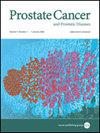机器人辅助根治性前列腺切除术后,经腹膜前路、保留尿道、腹膜外、经膀胱和会阴入路对尿失禁恢复的影响:比较研究的系统回顾和荟萃分析
IF 5.8
2区 医学
Q1 ONCOLOGY
引用次数: 0
摘要
背景:尿失禁显著影响根治性前列腺切除术患者的健康相关生活质量。在过去的几十年里,已经提出了几种机器人辅助根治性前列腺切除术(RARP)的方法(腹膜外、Retzius-sparing (RS)、会阴和经膀胱),目的是与经腹膜、前路手术相比,改善功能结果。方法:我们对近十年来以英语发表的研究进行了系统回顾和荟萃分析,比较了用于执行RARP的不同方法。我们只纳入了在不同随访时间点报告尿失禁率的研究。从每个符合条件的研究中,我们提取了分析患者的数量;研究设计;自制的定义;如果可以的话,立即,1个月,3个月,6个月和12个月的尿失禁率。统计分析使用RevMan version 5.4 (Cochrane Collaboration, Oxford, United Kingdom, UK)进行。比值比(OR)与95%置信区间(CIs)使用一般逆方差计算。结果的A p值:比较前路RARP、经腹腔RARP和RS-RARP在即刻(OR = 3.73;95% ci: 2.17-6.43;结论:在主要为低到中等质量证据的限制下,在MP-RARP患者不同随访时间点的尿失禁恢复方面,RS入路与前路经腹膜入路相比具有显著优势。MP会阴和经膀胱入路需要进一步测试,可能对SP-RARP的设置感兴趣。我们的荟萃分析显示SP-和MP-RARP在尿失禁率方面具有可比性。本文章由计算机程序翻译,如有差异,请以英文原文为准。

Impact of transperitoneal anterior, retzius-sparing, extraperitoneal, transvesical and perineal approaches on urinary continence recovery after robot-assisted radical prostatectomy: a systematic review and meta-analysis of comparative studies
Urinary incontinence significantly impacts on health-related quality of life of patients undergoing radical prostatectomy. In the last decades, several approaches (extraperitoneal, Retzius-sparing (RS), perineal and, transvesical) for robot-assisted radical prostatectomy (RARP) have proposed with the aim to improve functional outcomes in comparison with transperitoneal, anterior ones. We performed a systematic review and meta-analysis of studies published in English language, in the last ten years, comparing the different approaches used to perform RARP. We included only studies reporting urinary continence rates at different follow-up time points. From each eligible study, we extracted the number of analyzed patients; the study design; the continence definition; and, when available, immediate, 1-, 3-, 6-, and 12-mo urinary continence rates. Statistical analyses were performed using RevMan version 5.4 (Cochrane Collaboration, Oxford, United Kingdom, UK). The Odds Ratio (OR) with 95% confidence intervals (CIs) was calculated using the generic inverse variance. A p value of <0.05 was set as significance level when comparing studies. The meta-analyses of studies comparing anterior, transperitoneal RARP and RS-RARP in terms of immediate (OR = 3.73; 95% CI: 2.17–6.43; p < 0.0001), 1-mo (OR = 4.16; 95% CI: 2.68–6.48; p < 0.00001), 3-mo (OR 4.71; 95% CI: 3.70–6.00; p < 0.0001), 6-mo (OR 4.12; 95% CI: 2.95–5.75; p < 0.00001) and 12-mo (OR = 3.25; 95% CI: 1.76–5.99; p < 0.00001) urinary continence rates showed a statistically significant advantage in favor of RS approach. However, a sub-analysis of Randomized Controlled Trials showed overlapping urinary continence rates between the two approaches at 6-mo (OR = 1.99; 95% CI: 0.90–4.42; p = 0.09) and 12-mo (OR = 1.36; 95% CI: 0.43–4.31; p = 0.60) after surgery. The meta-analysis of studies comparing extraperitoneal and transperitoneal approaches showed that 6-mo urinary continence rates were overlapping between the two approaches (OR = 1.18; 95% CI: 0.85–1.65; p = 0.32). The meta-analysis of studies comparing single-port (SP) and multi-port (MP) RARP showed comparable 6-mo urinary continence rates (OR = 0.93; 95% CI 0.65–1.33; p = 0.69). Within the limitations of mainly low to moderate quality of evidence, the RS approach offers significant advantages compared to an anterior, transperitoneal, approach in terms of urinary continence recovery at different follow-up time points in patients who underwent MP-RARP. MP perineal and transvesical approaches need to be further tested and might be of interest in the setting of SP-RARP. Our meta-analysis showed comparable results between SP- and MP-RARP in terms of urinary continence rates.
求助全文
通过发布文献求助,成功后即可免费获取论文全文。
去求助
来源期刊

Prostate Cancer and Prostatic Diseases
医学-泌尿学与肾脏学
CiteScore
10.00
自引率
6.20%
发文量
142
审稿时长
6-12 weeks
期刊介绍:
Prostate Cancer and Prostatic Diseases covers all aspects of prostatic diseases, in particular prostate cancer, the subject of intensive basic and clinical research world-wide. The journal also reports on exciting new developments being made in diagnosis, surgery, radiotherapy, drug discovery and medical management.
Prostate Cancer and Prostatic Diseases is of interest to surgeons, oncologists and clinicians treating patients and to those involved in research into diseases of the prostate. The journal covers the three main areas - prostate cancer, male LUTS and prostatitis.
Prostate Cancer and Prostatic Diseases publishes original research articles, reviews, topical comment and critical appraisals of scientific meetings and the latest books. The journal also contains a calendar of forthcoming scientific meetings. The Editors and a distinguished Editorial Board ensure that submitted articles receive fast and efficient attention and are refereed to the highest possible scientific standard. A fast track system is available for topical articles of particular significance.
 求助内容:
求助内容: 应助结果提醒方式:
应助结果提醒方式:


